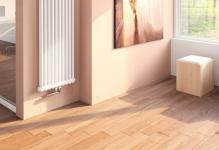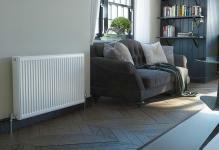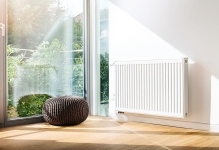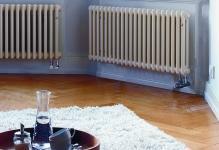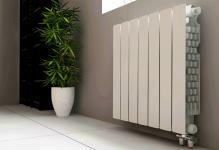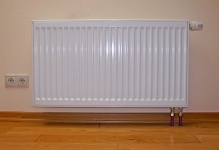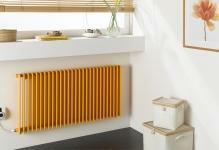 Installation of radiators includes several consecutive stages Installation of heating devices is a responsible and time-consuming process. It is important to know not only the procedure itself, but also such nuances as how far to hang radiators. Much depends on the material of the manufacture of batteries. But if you want to build a structure you can do it on your own.
Installation of radiators includes several consecutive stages Installation of heating devices is a responsible and time-consuming process. It is important to know not only the procedure itself, but also such nuances as how far to hang radiators. Much depends on the material of the manufacture of batteries. But if you want to build a structure you can do it on your own.
-
- How to choose a heating radiator for self-assembly
- How to install heating radiators
- Heating scheme and rules for heating
- Selecting the location of heating batteries in a private house
- Installing heating batteries: preparatory work
- Installation of the radiator with your own hands in the apartment
- How to install the heating radiator yourself( video)
- Examples of heating radiators( photo)
How to choose a radiator for self-assembly
Radiators are classified after the material of manufacture. Thus, cast iron, aluminum and copper batteries are distinguished. Each option has its pros and cons.
Cast iron has a high heat output. The material requires more time to warm up, but also the heat is held longer. Products are heavy, only one section can weigh 10 kg. In addition, periodically the battery will need to be tinted.
The main advantage of cast iron is the ability to withstand a coolant temperature of up to 150 degrees. The composition of the liquid is not particularly important.
Aluminum is considered the most popular material for radiators. The reason for this is good heat transfer, low cost and compliance. So from aluminum it is possible to make a battery of any configuration.
 Heating radiators are classified according to the workmanship
Heating radiators are classified according to the workmanship
Cons of aluminum radiators:
- Poorly perceived pressure drop. At high swings, the structure may burst.
- Demanding to the state of the coolant. Due to poor quality of water, the material is corroded.
Steel batteries are manufactured in the form of monolithic blocks, not sections. Such options are more suitable for an individual heating system. Advantages and disadvantages of steel radiators are in equal quantities. Among the advantages are high heat emission. But steel quickly rusts.
Increasingly, batteries use alloys with metal. So aluminum is combined with steel or copper. This increases the thermal characteristics of the material. At the same time, strength, lightness and durability of products are noted. Of the minuses only high cost.
Mounting methods for heating radiators
Everybody can mount radiators, because the system is quite simple. But it is important to follow the building rules and regulations. According to them, several ways of mounting are distinguished.
Battery installation methods:
- Side;
- Lower;
- Diagonal.
Side connection is much more common. The pipe inlet and outlet is mounted on one side of the radiator. True, the connection to the fittings is different, so the opening is attached to the top, and the output one to the bottom one.
This option provides a certain interval between the fittings. Otherwise, the battery will not warm up completely. If the radiator itself has many sections, then you will have to use an extension cord.
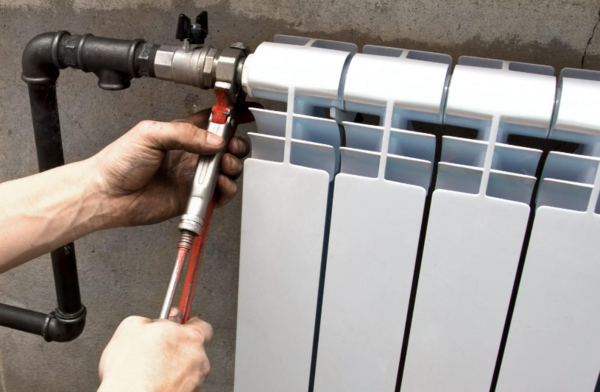 Process for installing the heating radiator
Process for installing the heating radiator
The lower assembly is for connecting the inlet pipe with the bottom connection on one side, and the outlet assembly with the lower one on the other side.
Sometimes both nozzles are placed on the bottom. In this case, the lower connection is mounted. But this option reduces heat dissipation.
The diagonal variant is considered the best. The inlet pipe is connected to the union from the top, and the outlet pipe from the bottom. The heat loss is minimized there as much as possible.
Connection is divided into serial and parallel. The first option involves the output of one pipe entry for another. This is a closed system that requires the installation of a booback. This is a special tube that connects the inlet and outlet pipes. Parallel connection means a different tap for each pipe.
Diagram and rules for heating
Each connection variant can be used in a single-pipe and two-pipe design. The first option involves the installation of radiators by one system, where the liquid flows from the top down. In a private house, such a system is unprofitable, since the lower radiators warm up poorly.
The two-pipe circuit has more advantages. The hot fluid enters one riser, and is discharged into the other. This wiring is often found in homes, as it can heat all rooms.
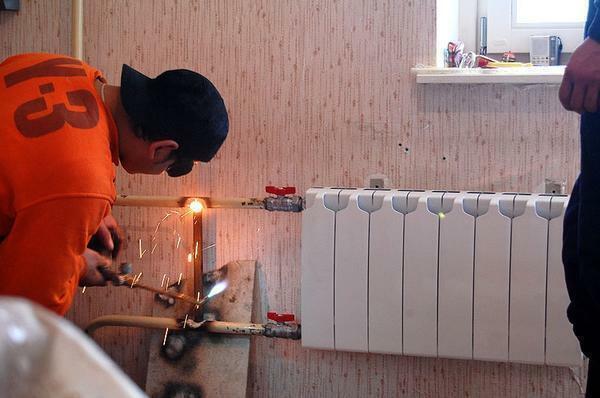 The process of installing radiators consists of several stages
The process of installing radiators consists of several stages
Self-installation instructions for batteries:
- The radiator must be placed horizontally, without distortion;
- There should be a distance of 5-10 cm between the top and the window sill;
- From the floor to the battery, an interval of 8-12 cm is provided;
- There is a gap of 2-5 cm from the radiator equipment to the wall;
- Tighten the valve with a maximum force of 12 kg, it is better to work with a torque wrench.
The installation process consists of several steps. First, you need to dismantle the old radiator. Then it is determined with a place, fix the brackets and hang the batteries. Next, install a stop valve and connect the pipes. In theory, everything is simple, but the practice has many nuances.
Choosing a place for installing heating batteries in a private house
To hang a device with your own hands, it is worth remembering that the branch pipes to the batteries are mounted with a slight inclination towards the heat carrier. In the event of distortions and strictly vertical placement, air can accumulate in the batteries.
The central axis of the radiator must coincide with the central axis of the window.
Small deviations of a couple of centimeters are allowed. Visually everything should be smooth. But this is an optional condition to put a radiator.
 To increase the heat transfer of the instrument, some manipulations can be carried out before installation.
To increase the heat transfer of the instrument, some manipulations can be carried out before installation.
Recommendations for positioning:
- The slope of the feed pipes should be 0.005-0.01.This means that each linear meter of the pipeline tilts by half a centimeter.
- From the floor to the radiator observe an interval of 6-10 cm, from the windowsill - 5-10 cm, from the wall - 2-5 cm.
- The horizontal and vertical directions are compulsorily observed.
In order to increase the heat transfer of the device, some manipulations can be performed before installation. So install a shield of heat-reflecting material. Or make a coating with a tool with similar properties.
Installation of heating batteries: preparatory work
First you need to remove old batteries. To do this, turn off the water supply. You can also simply close the shut-off valve. When connecting the system to the highway, the riser is blocked. In a private home, the definition of the optimal time of work depends entirely on the wishes of the owner.
 Before installing batteries, it is necessary to carry out the preparatory work
Before installing batteries, it is necessary to carry out the preparatory work
Preparatory work before replacing the radiators:
- Determine the duration of the work;
- Take care of all tools and materials;
- Get permission to turn off the network in the service company, you have to pay for it;
- Close the riser at the permitted time.
This sequence of work is carried out during the heating period. In the summer time there is no liquid in the pipes. This information can be specified in the fitter who serves the house. That's why the battery replacement is actual in the warm season.
Installation of radiators with own hands in the apartment
To get started, you should read the list of necessary tools. You need to stock up with a drill with a winning drill. The list of tools includes torque wrenches, a screwdriver, pliers, a tape measure, a level, a pencil with a ruler. In general, the characteristic composition of the box with tools.
Assembly steps:
- First the heating system is switched off and the liquid is drained. In private buildings, a pump is used for these purposes, and apartments need to be contacted in the housing and utilities sector. Then disconnect the old structures.
- Then carry out marking for the brackets. For a correct and even installation you will have to apply the building level. The horizontal installation will eliminate the gas content of the system and allow the drainage of the water completely.
- Then mount the brackets. It is important to check the devices for strength, pressing them down with their weight. For cast iron and aluminum radiators only 2 fasteners are used. For plastic, more elements are needed. The walls must be clean, smooth, plastered.
- Then the shut-off valve is installed. All connections are reliably sealed. Then connect the pipes. To connect the structure to the pipeline, it will be necessary to make the thread on the driveways. Now for heating use metal-plastic pipes.
 Battery installation in the apartment can be done manually
Battery installation in the apartment can be done manually
To prevent leakage, use a torque wrench. This is an obligatory element when installing aluminum pipes, where the installation of an air valve is mandatory. In this case, the force on the tool should not exceed 12 kg.
During installation, no need to remove the protective film from the radiators.
For the sealing of joints, a harness or any other sealant is used. After installation, crimping is required. These jobs should be entrusted to a professional. He has a special tool and the necessary skills. If a leak is found, you need to adjust the nipple.
To install heating radiator yourself( video)
To install batteries in the apartment, you do not need special skills. It is enough to get the proper permits. Install radiators should be based on building codes and consistent instructions. To fix the device at a height, an American and brackets are used. A stand is used for the floor installation. The sequence of assembly of devices is the same, the features of the material are rocked.
Examples radiator units( pictures)


